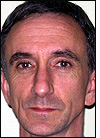Gentag, an intellectual property (IP) development company in Washington, D.C., has been granted a new patent, which it says it will use to create technology for turning cell phones into universal RFID interrogators able to read passive RFID tags and wireless sensors.
“The patent specifically covers the use of personal wireless devices in wireless networks, but also with RFID and sensors,” says John Peeters, Gentag’s founder and president. “The idea is to create low-cost RFID sensor networks for consumers.” Gentag co-owns Patent No. 7,148,803 with Symbol Technologies because Peeters coinvented the technology with former Symbol executive William Bandy; each company retains independent rights on the patent.
According to Peeters, Gentag will initially focus on applying the technology toward health-care applications. For instance, he says, with a cell phone as a reader, consumers could interrogate disposable, adhesive skin patches embedded with passive RFID tags and temperature sensors. Such smart-patch technology could provide an inexpensive tool to monitor health: A parent could use it to monitor a child’s temperature to watch for fever spikes, for instance, or caregivers could monitor patients in hospitals.
In addition, Gentag will use the patent to develop other RFID-enabled applications, including skin patches for monitoring glucose, heart activity, and ultraviolet radiation. It could also develop a biomarker skin-test patch, which doctors could utilize to indicate or measure a wearer’s biological processes.
Unique to the smart skin-patch technology developed by Gentag is what Peeters calls single-point calibration. Typically, he explains, whenever sensors are calibrated or adjusted , several measurements are needed for the task. Gentag’s technology, however, allows one calibration point of temperature to serve as the reference point.
“We’ve removed the hurdle of expensive sensors. This allows for the production of a very low-cost, disposable passive RFID sensor tag,” Peeters says. “It makes the technology an extremely cheap add-on cost to the chip. Fabrication of [the single-point calibration] is only about one cent.” Gentag’s RFID sensors, he adds, will work with both high-frequency (13.56 MHz) passive tags, regardless of standards, and ultrahigh-frequency (915 MHz) EPCglobal Gen 2 tags.
The company is currently exploring and developing applications of its technology in other areas, and has several other patents, as well. For example, says Peeters, a cell phone could be fitted with a removable sensor module consisting of a sensor with a unique ID (akin to an active RFID tag) and a carbon monoxide (CO) sensor. The sensor would be powered by the cell phone’s battery, even if the phone were turned off. With the module attached to the phone, the smart cell phone could sound an alarm if high CO levels were detected.
The removable module allows for the flexibility to use various types of sensors in a single phone, Peeters claims. “Our vision is to have one cell phone that can do a number of things.” If users wanted to use another kind of sensor, he says, they could remove the carbon monoxide sensor and swap in another in its place.
Gentag has already demonstrated its technology with Palm’s Treo smart phone, says Peeters. The RFID temperature sensors are currently in development, and he expects them to be commercially available in six to nine months. Gentag will license its technology, and it also plans to sell products itself. In addition, the company intends to launch a pilot with an Asian company in the first part of 2007, though Peeters has declined to elaborate on the details of this deployment.
“This patent, which enables the use of cell phones as the readers, is really an exciting paradigm shift. We’re now shifting from proprietary expensive readers to very low-cost readers that are available to the public,” Peeters says. “It is opening a new door.”


